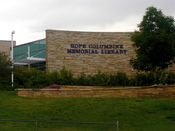If someone were to rely solely on television media, it wouldn't surprise me if he/she thought that America's schools were being taken over by these so-called "juvenile super predators." The American people would assume that every quiet kid who gets picked on is going to turn around in school one day and start unloading his newly acquired firearms on his peers. This is hardly the case. While there may be an occasional "super-predator," the media has highly over publicized these rare, extraordinary events.
Perhaps the most notorious school massacre was at Columbine High School. It was here, in 1999, that two male students murdered twelve students, one teacher, and then committed suicide (Internet Site #4). We viewed a film, The Killer at Thurston High, and saw Kip Kinkel not only shoot up his high school, but also murder his parents. These few extraordinary children strike fear in the hearts of America's parents every morning when they send their own children off to school.
However, the likelihood of a child being murdered as a result of a school-associated violent incident is less than one in one million, and less than one percent of children murdered in 1992 and 1993 were killed on school property (Kappeler, 187). The Center on Juvenile and Criminal Justice reports that the likelihood of a child dying in a school related incident is actually one in two million (Brooks, 1)! The National Commission on Child Abuse and Neglect reports that 2,000 to 3,000 children are murdered annually by their parents, opposed to approximately two-dozen children murdered in schools (Kappeler, 187).
It seems to go hand in hand that while people are being convinced that school murders are occurring more frequently, various types of school violence also seem to be rising. This is once again a myth. The United States Departments of Education and Justice distributed a survey to students both in 1989 and 1995. It was reported that the students only felt a .1% increase in the total level of victimization (Kappeler, 188). As a matter of fact, only one in ten public schools report any sort of violence at all (Kappeler, 189).
The reasons behind the rare violent outbursts of children remain some sort of a mystery. As we saw in Kip Kenkel's story, it is easy for kids today to get wrapped up in violent popular culture. Today, extremely violent movie scenes and music lyrics about murder and violence plague children. People like to try and rationalize the kid's motives and in doing so, they also like to believe that there are ways to help prevent these heinous crimes. Christi Parsons recommends that children become more involved in positive extra-curricular activities (Struckhoff, 50). Many argue that the best and simplest way to prevent acts of violence is to have a strong parent/child relationship. Discipline begins in the home. As for violence with firearms, the most obvious preventative measure would be to have stricter control over firearm and handgun access (Struckhoff, 54). There is no reason that children should have any access to handguns. Unfortunately, there are those few exceptions, like Kip's story, when the child's parents actually provide the guns. There are also programs that can be provided by the schools to inform children about violence and safety. Many of these types of programs are listed on the OJJDP website, such as: violence prevention programs with parent or community involvement, counseling, activities involving individual attention for students, and student involvement in resolving student conduct problems (Internet Site #5).
School violence is not nearly as large an issue as the media has made it out to be. Parents should feel confident that their children will return home to them at the end of the day unharmed. Unfortunately, there will always be those few exceptions; those few Kip Kenkels that will continue to haunt the minds of the innocent. The images of Columbine are forever etched into our minds, but hopefully people will soon learn that children are actually I more danger at home and during free time rather than in school.






